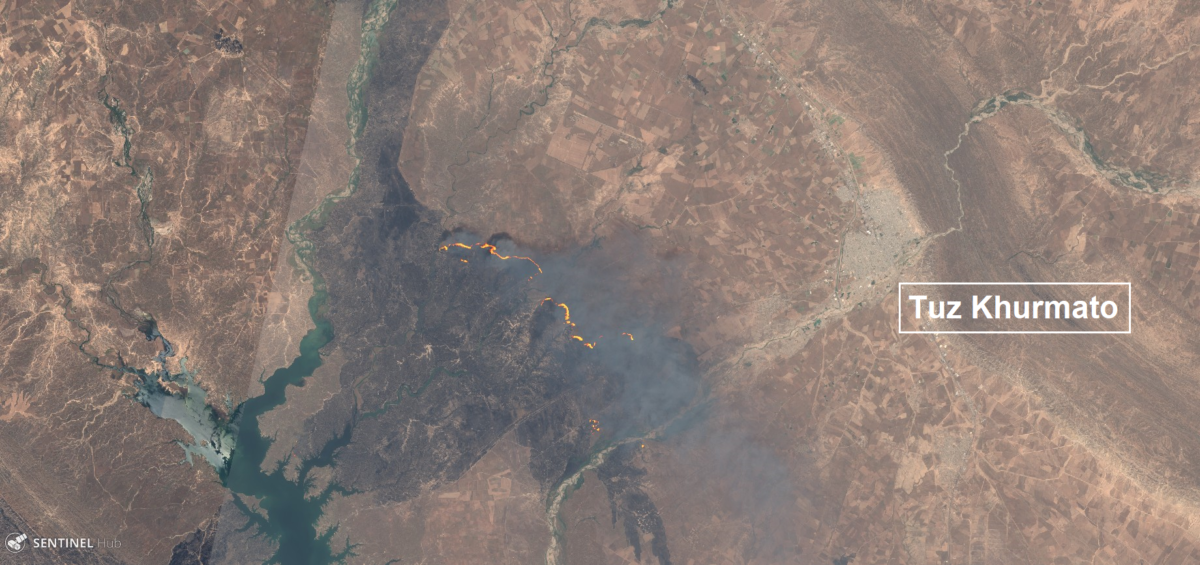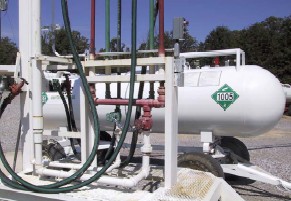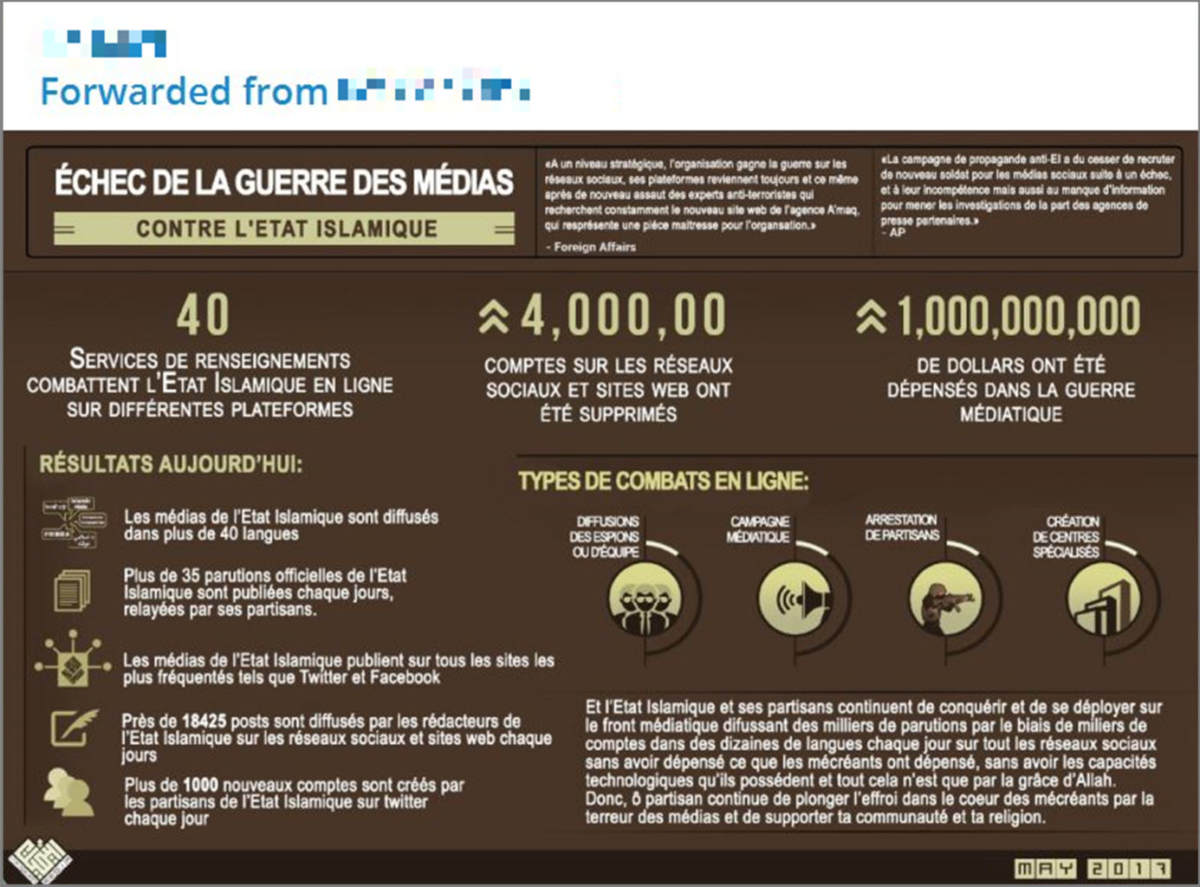Types of Islamic State Drone Bombs and Where to Find Them
The proliferation of armed, commercially sourced drones has become a fact of the current conflict in Iraq and Syria. Jund Al Aqsa, Hezbollah, so called Islamic State (IS) and Iraqi Government forces have all used commercial drones which have been modified to carry either improvised bombs, or in the case of Hezbollah, sub-munitions from a cluster bomb. The types of munitions dropped by drones is surprisingly varied, and different kinds of drone bombs appear in different theatres of conflict, no doubt influenced by a wide range of different factors from the people who make them, to the materials available.
The Drone Strike Database has logged images of 121 strikes using media released by IS up to 23 May 17, and includes a spreadsheet showing the earliest identified date the strike was published, as well as the location, presumed target and kind of munition used in each strike. This data has been input into a Silk, allowing readers to explore the data for themselves. The Silk includes an interactive map where we can see details of how particular types of IS drone bombs can be found in distinct geographical locations. Please note that Silk is no longer supported and its user interface can take a while to understand, but once it has been mastered it can provide an excellent place to view data.
This article uses the data set to analyse and log the different kinds of drone bombs that IS has used, where they have been used, and on what targets. By its nature, this data-set uses information that comes from IS, and so it must be understood that this is not a complete representation of IS drone operations. Rather it is a subset of their drone operations presenting strikes they wished to be seen. It should also be noted that the location of these drone strikes is rough, and accurate only at provincial level, except where exact co-ordinates have been specified. Strikes which contained no information about their location have been geo-tagged to a location in the Mediterranean Sea to keep them within the frame of the map, while making it obvious that their location is unknown.
This article will use several different terms that should be defined before we move into the presentation of the data:
- A “strike” is the use of drone to drop one or more munitions on a single target.
- Due to the nature of IS drone bombs, with various munitions and tails being combined to form different kind of bombs, this article will refer to “warheads”, “intermediate sections” and “tails”. While the warhead in the image below shows a physical example, within the data “warhead” is the section of the drone bomb which provides the effect on target, whether high explosive or otherwise.
- Within the database, “intermediate sections” are referred to. These appear on many drone bombs but we are still unsure as to their exact nature.
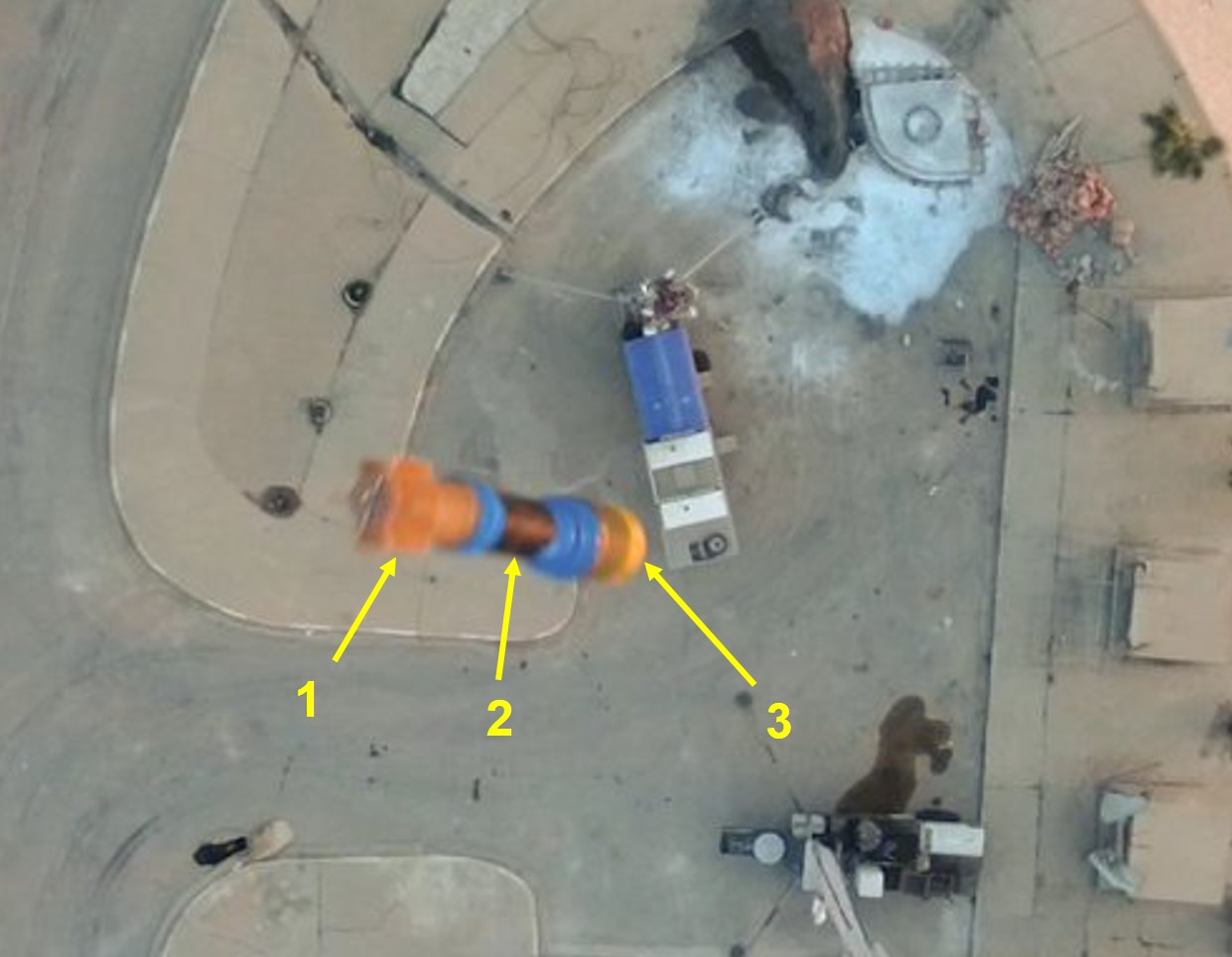
Here we can see three clear sections: 1 – Tail, 2 – Intermediate Section, 3 – Warhead (in this case a 40mm grenade)
We will now examine three different entities: warheads, tails and targets, analysing each one in turn.
Warheads
IS have used a bewildering array of different kinds of warheads for their bombs, ranging from 40mm grenades to munitions that remain entirely unidentifiable.
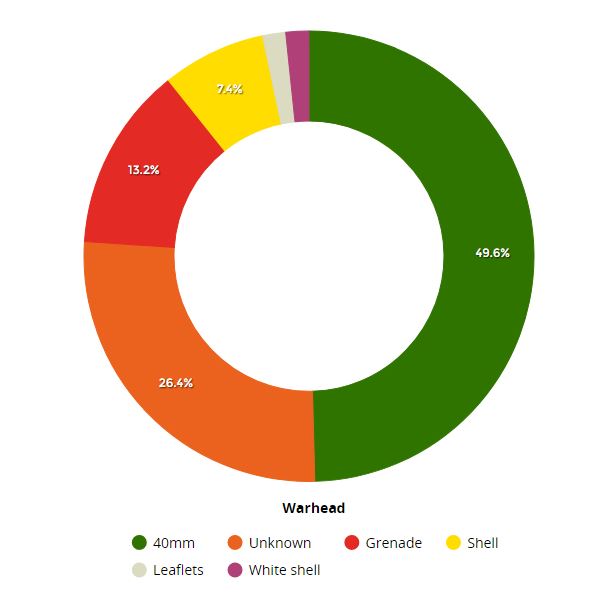
Types of warheads used on IS drone bombs
The graph above shows the breakdown of the different kind of warheads used. As we can see, the most common warhead uses 40mm grenades, with a large number of unknown warheads, either due to lack of imagery, or because the warhead could not be clearly identified. We will now examine each kind of warhead in turn.
40mm warhead
40mm grenades have been the most featured warhead on IS media, with 60 depicted so far, approximately 50% of the total. As we can see these have been used exclusively in Iraq, with the majority being used in or around Mosul. These warheads are seen in two varieties, as an individual 40mm grenade, or modified with a second 40mm grenade attached to the first, which will be referred to as “40mm double”.
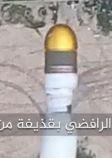
Individual 40mm warhead
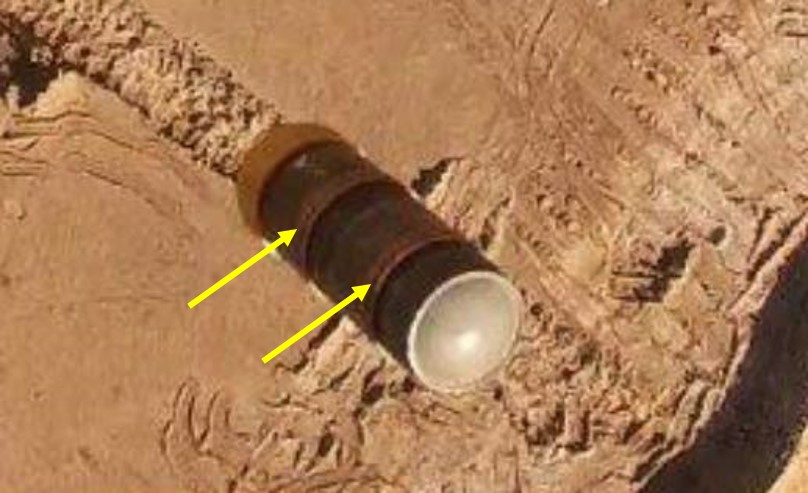
Double 40mm warhead. The two yellow arrows point out the two driving bands, clearly marking this as two 40mm grenades that have been attached together
In the map below we can see that within IS media, 40mm warheads are seen exclusively in Iraq. We can also see the distribution of double 40mm, with the largest number (four out of nine instances) being seen in the vicinity of Haditha.
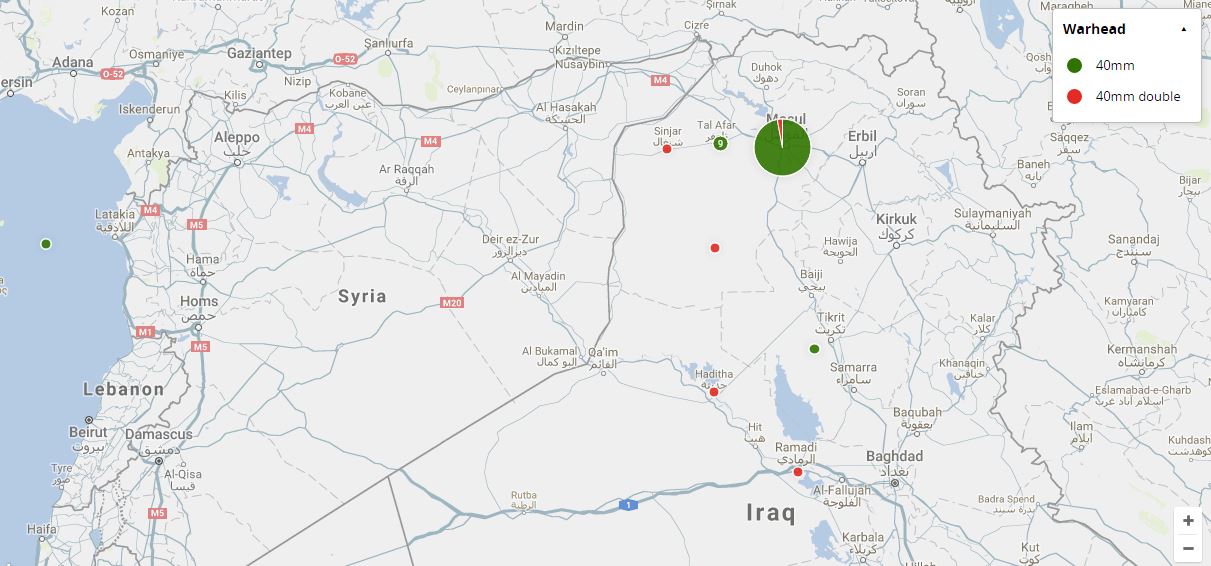
Geographic distribution of 40mm drone bombs
Grenade warhead
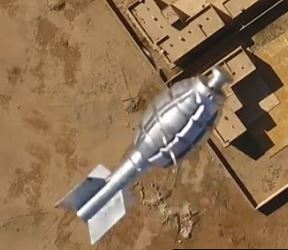
Example of a “grenade” warhead
Although named “grenade” due to its resemblance to an American Mk 2 “pineapple” grenade, the exact nature and origin of this warhead is unknown. However, it seems to be a staple of the IS drone armoury, especially around Deir Ezzor. “Grenade” warheads account for 16 of the strike seen in IS media, or just over 13% of the total.
We can see from the map below that the vast majority of this kind of warhead have been seen in Deir Ezzor, with one each in Tal Afar, Hama and Homs.
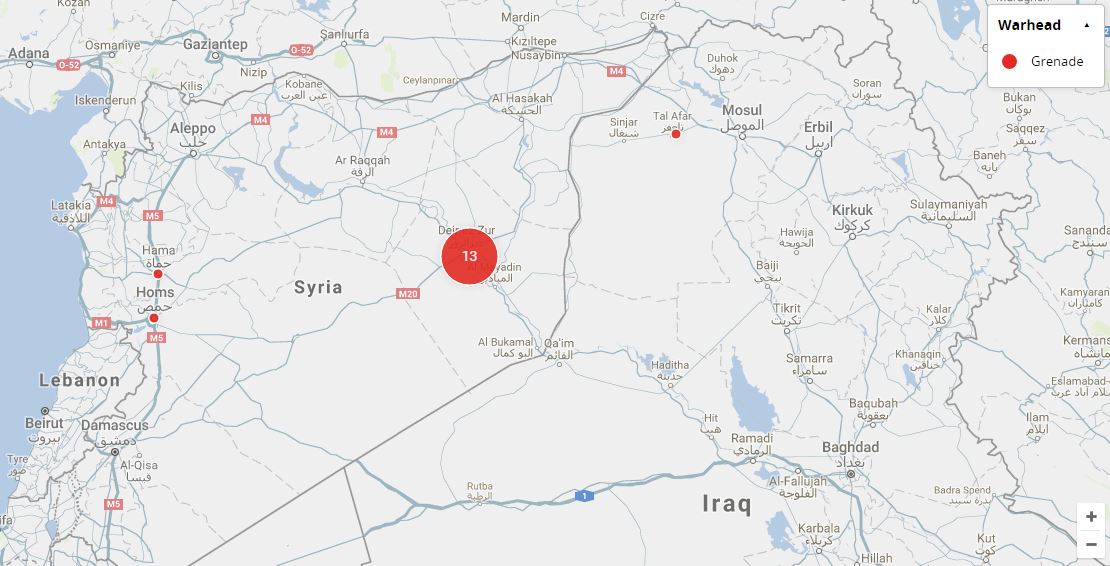
Geographic distribution of “grenade” warheads
Shell warhead
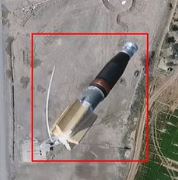
Example of a “shell” warhead
These munitions appear to be some kind of larger-calibre round (possibly 20-40mm) modified for the purpose of dropping from drones. Due to the lack of clear imagery it’s not possible to say conclusively if these are all the same type of round, but they appear visually similar and so have been grouped together. “Shell” type munitions have been seen nine times, just over 7.5% of the total.
We can see from the map below that this kind of warhead has been seen in Deir Ezzor (three), Raqqa (five) and Salahuddin Province (one).
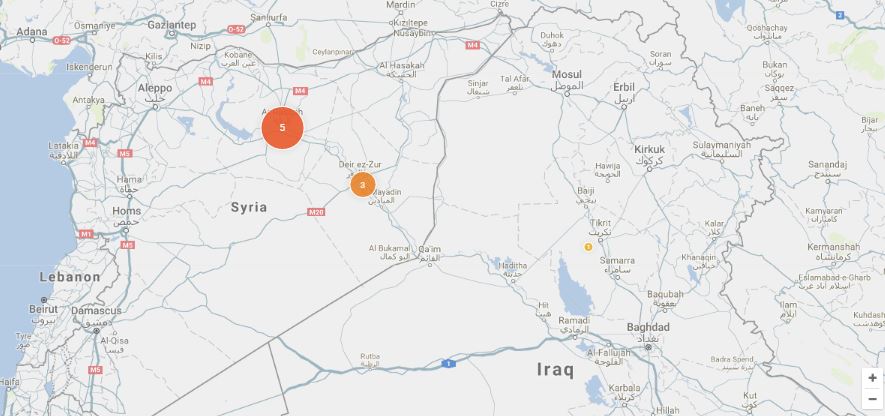
Geographic distribution of “shell” warheads
White Shell
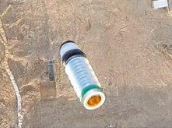
Example of a “white shell” warhead
These shells have only been seen twice, both in the vicinity of Al Rutbah, but appear to be some kind of conventional munition. These shells have not been positively identified, so any further information on these kind of munitions from our readers would be greatly welcome.
Leaflets
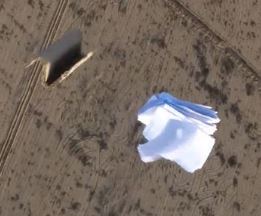
Example of leaflet drop
IS media has twice depicted leaflets being deployed by drones, both in a single video from Deir Ezzor. The exact contents of the leaflets is not described in the video.
Unknown
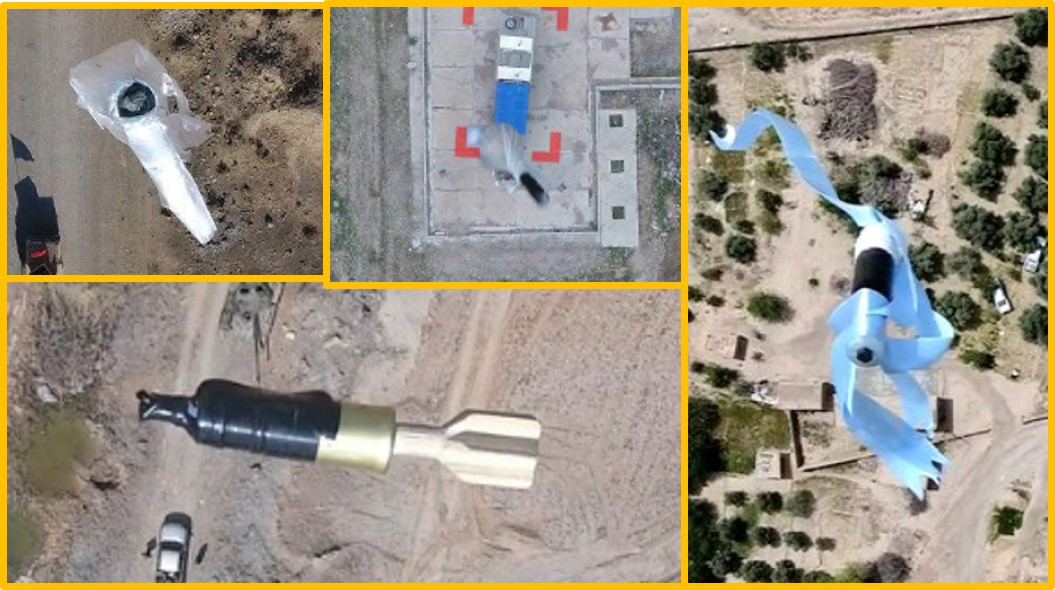
Examples of unknown drone warheads
We have seen a large amount of media in which the bomb itself is either not seen, so indistinct as to be impossible to identify, or of a nature that has not yet been identified. Unsurprisingly the geographic distribution of these “unknown” munitions reflects the total distribution of IS drone bombs. As with the “White Shell” munition, we would welcome any information regarding these unknown munitions, especially of the kind seen recently around Raqqa.

Examples of unknown “Raqqa” warhead
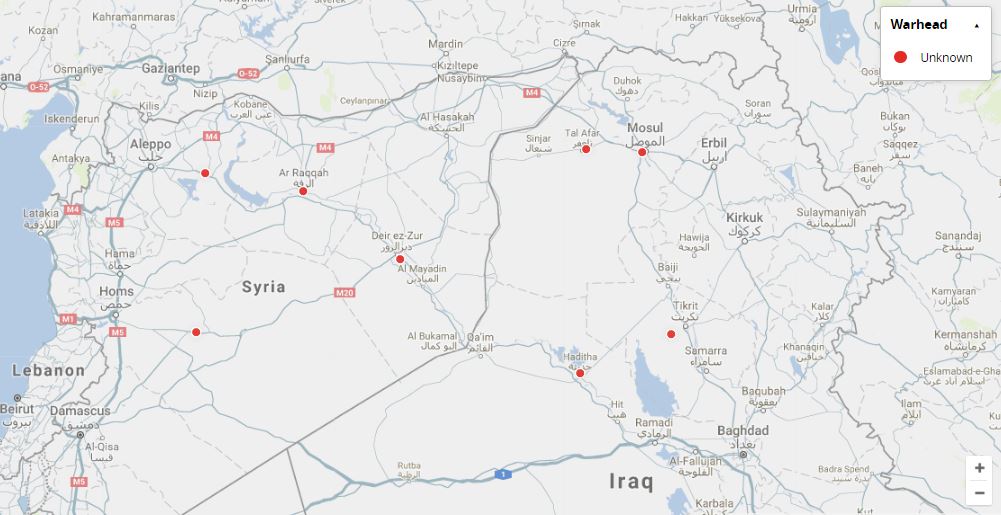
Geographic distribution of unknown warheads
Tails
The tail is an important part of a drone bomb. They make the bomb far more accurate, and ensure that the bomb lands nose first, giving it a higher probability of detonating. Within IS drone media we have seen several different tails, including parachutes, streamers and what appear to be industrially manufactured plastic tails. The graph below displays this breakdown.
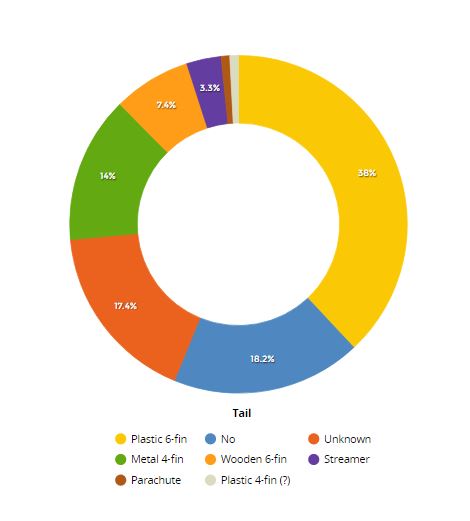
Breakdown of different tails
As with warheads, we will now examine each tail in turn.
Plastic 6-fin tail
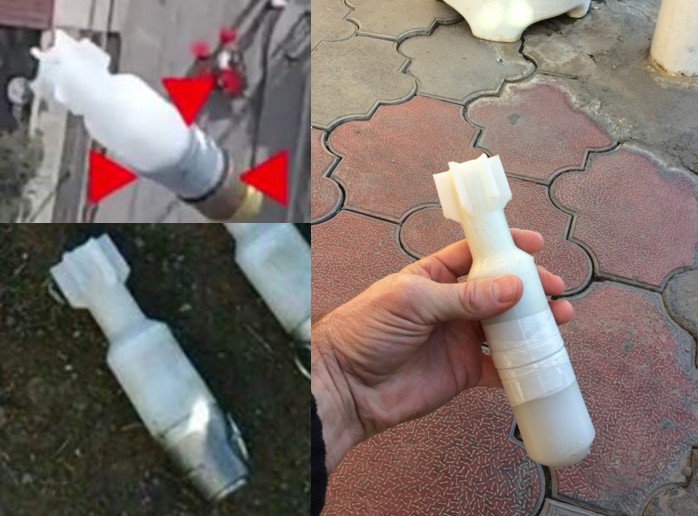
Examples of plastic 6-fin tail
Previously we were informed by a highly qualified source that these tails were produced by a CNC milling machine. However, this has been thrown into doubt by a report from the Conflict Armament Research group, which indicates that the tails may indeed have been moulded. Without having examined these munitions in person the author cannot authoritatively say how these tails were manufactured.
We can see from the map below that plastic 6-fin tails are exclusively seen in Iraq, with the majority being seen in Mosul (31) and Tal Afar (10). Four have been identified as being from Salahuddin Province, while a single strike had no indication of location. These tails have been seen in just under 40% of the strikes and are by far the most prominent tail type.
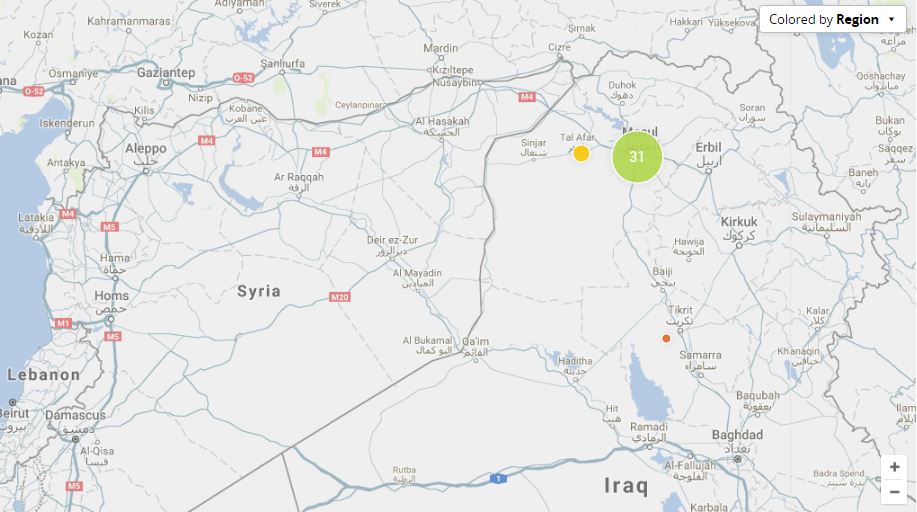
Geographic distribution of plastic 6-fin tails
Metal 4-fin tail
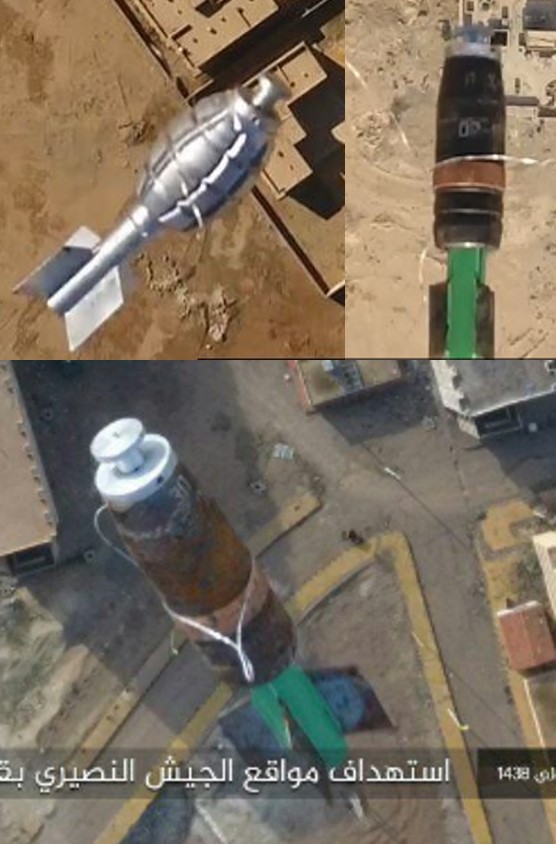
Examples of metal 4-fin tail
Although distinct from other tails, this tail varies slightly in size and shape, though the basic constructions remains the same: four metal fins attached to a cylindrical metal stem. We can see that this style of tail has only been seen in Southern and Western Syria, with the vast majority (15) being seen in Deir Ezzor, with one each in Homs and Hama provinces. These tails have been seen in 14% of the drone strikes within the database.
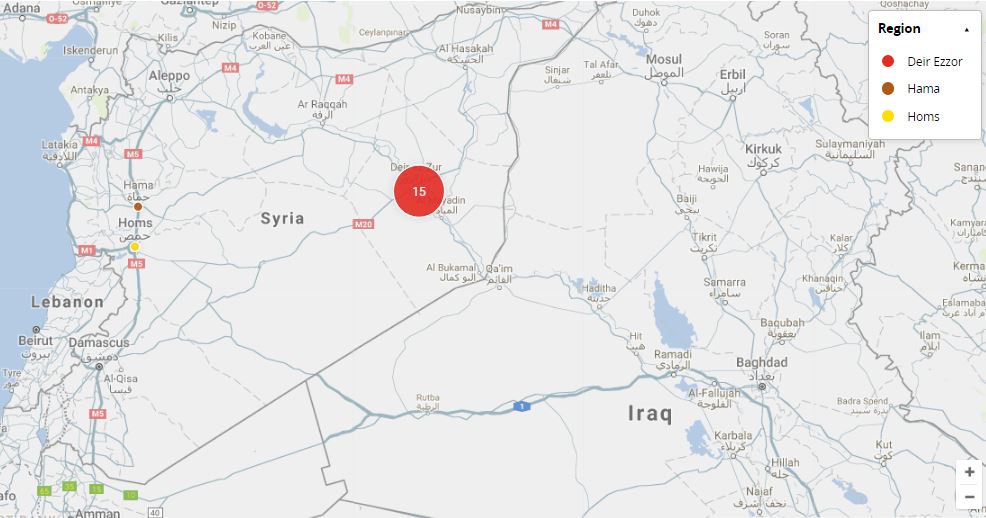
Geographic distribution of metal 4-fin tails
Wooden 6-fin
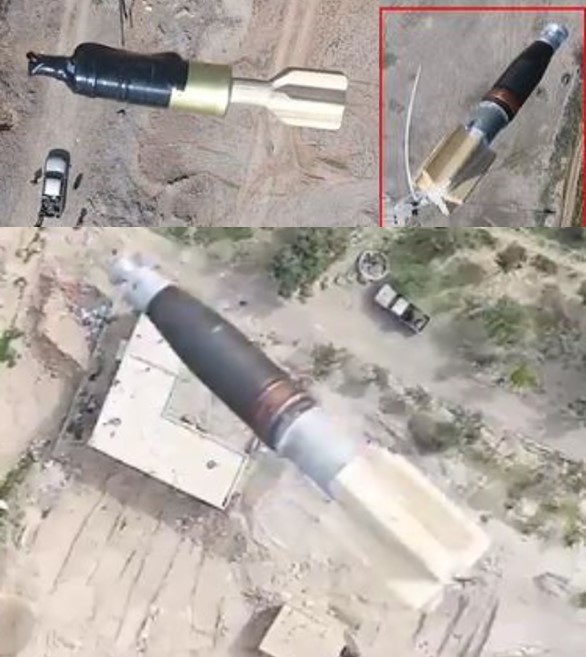
Examples of wooden 6-fin tail
This style of tail is a relatively late development, with the first being seen in IS media on 15 March 2017. These tails are quite distinctive and appear to vary in size and shape, although the basic construction is the same, with long, quite thick fins. They appear to be made out of wood, although at the time of writing this had not yet been confirmed. The majority (seven) of these tails have been seen in Raqqa, with one near Abo Makbara in Aleppo province, and one in Salahuddin Province. These tails are seen in just over 7% of the total strikes on the database.
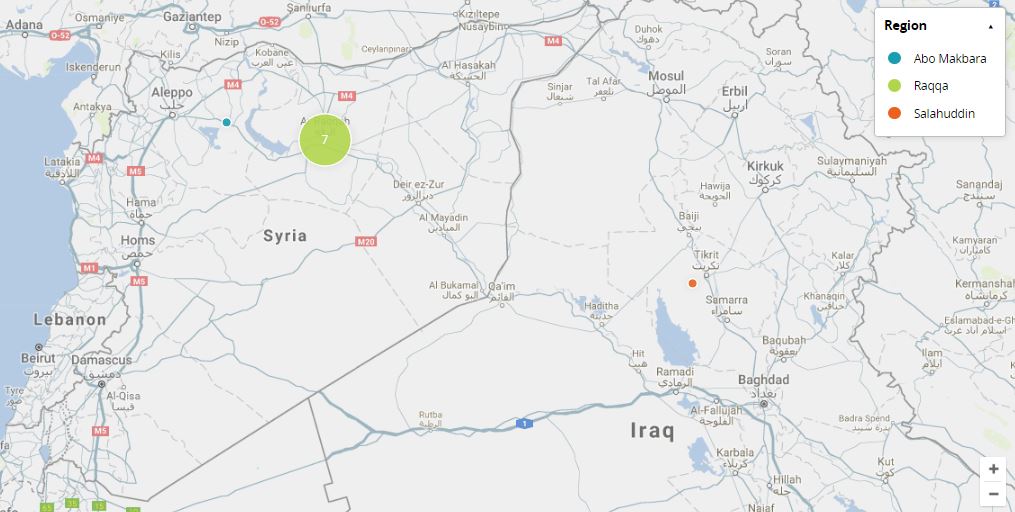
Geographic distribution of wooden 6-fin tails
Streamers

Examples of streamers
Streamers have been seen on only four drone bombs, representing just over 3% of the strikes. Of these, three strikes were published in February 2017, while a single strike was published in May 2017. One was seen in Raqqa province, two near Sinjar and one in Salahuddin province.
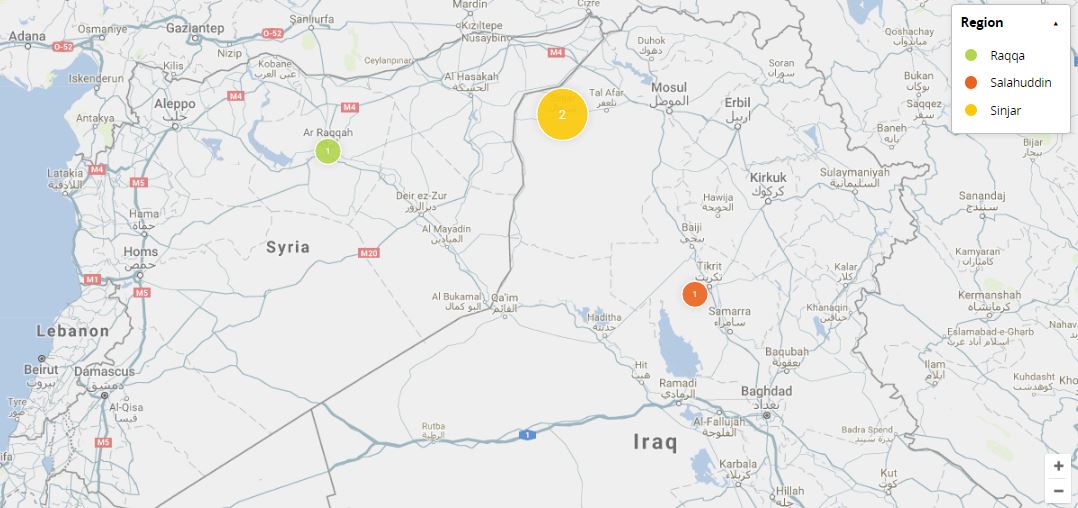
Geographic distribution of wooden 6-fin tails
Others
Two tails have been seen which do not fit in with other entities: a single use of a parachute in Salahuddin Province and the single use of what appears to be a white 4-fin tail which has not been possible to identify.
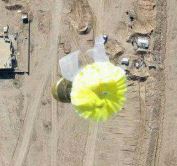
Example of parachute-type tail
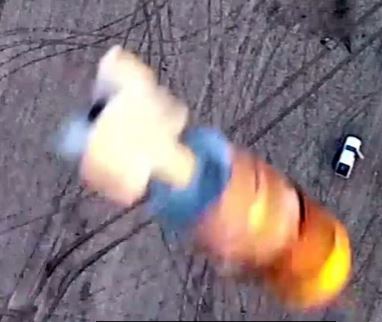
Example of unknown (possibly white 4-fin) tail
Targets
This section displays the kinds of targets IS has been hitting with their drones. Although it is not possible to say this is exactly what they were trying to hit, the database does show that these drone bombs, if dropped from a reasonable altitude, can be rather accurate, hitting groups of people, vehicles and fighting positions. This is a collation of what appears to be the main target of these strikes.
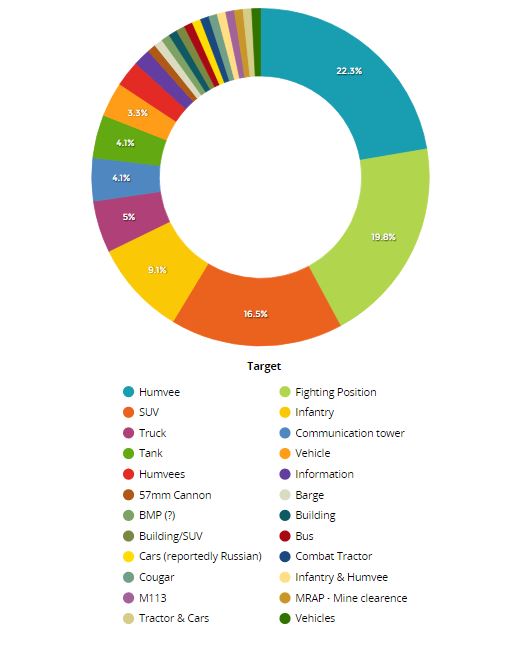
Graph showing the distribution of targets
As we can see, the most prominent target are Humvees, closely followed by fighting positions and SUV’s. Although the target set selected is influenced by the character of the terrain and capabilities of the opposition, we can see that unarmoured vehicles, comprising of Humvees, SUV’s, trucks, cars, busses and unidentified vehicles, represent 63 targets within this data set, or just over 51%. The exact reasoning for focusing on these vehicles is unknown. However, considering that vehicles represent a high-value target that is much easier to see from the air than infantry, and much more likely to be damaged than armoured an vehicle, they seems like an effective choice of target.
Despite this focus on unarmoured vehicles, IS still target armoured vehicles with varying levels of success. Within this dataset they have targeted five tanks, an M113, an MRAP with mine-clearance boom, what appears to be an armoured tractor and possibly a Cougar and BMP. In media released before this data set was compiled they had even targeted an Iraqi M1 Abrams tank, appearing to hit the commander.
Conclusion
These maps show that IS deploys a bewilderingly large number of different types of drone bombs, using a wide range of warheads and tails. Although the majority of the strikes published take place in the vicinity of either Mosul, Deir Ezzor or Raqqa, there are examples from across IS’s area of operations.
Attempts to tie individual characteristics to a single location appeared flawed. Although certain characteristics may be associated with particular regions, such as plastic 6-fin tails and Iraq, or metal 4-fins and South and West Syria, there is certainly potential for these assets to move around within IS territory. As the battle for Mosul comes to a close and IS faces increasing pressure on all fronts, forcing it to re-allocate assets, this potential will increase further.
However, hopefully this analysis may provide information which may be of use when confronted with an IS drone threat. A key lesson being that unarmoured vehicles are the most popular target, representing a high-value target that can be defeated by a drone bomb.
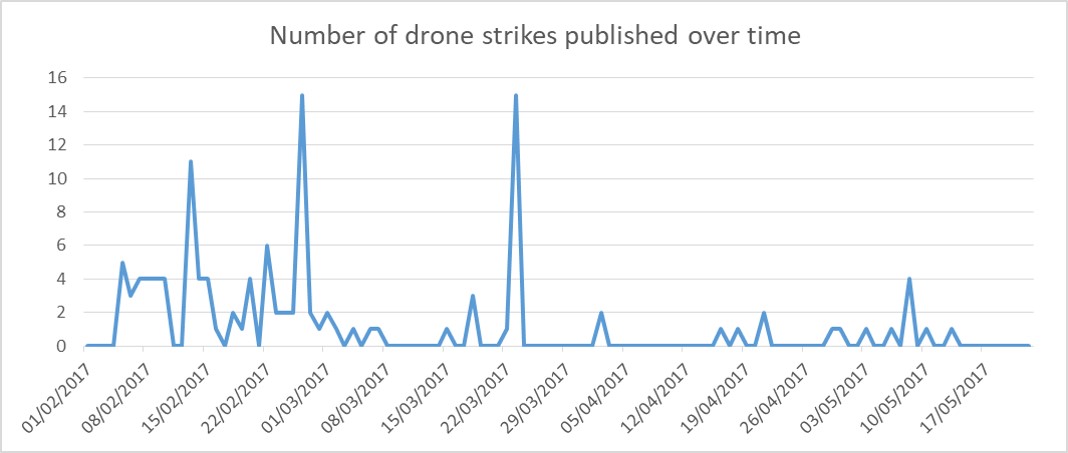
Looking at the numbers of IS drone strikes being published, there has clearly been a downward trend from the height of the battle for Mosul. However, IS drone assets still appear to be operating, and while Deir Ezzor remains an active front, the battle for Raqqa may see an uptick in attacks as anti-IS forces are drawn into yet another tough urban battle.
Many thanks are due to Paweł Wójcik (@SaladinAlDronni), Aldin Abazović (@CT_operative) and Abraxas Spa (@AbraxasSpa) for their assiduous drone hunting.
